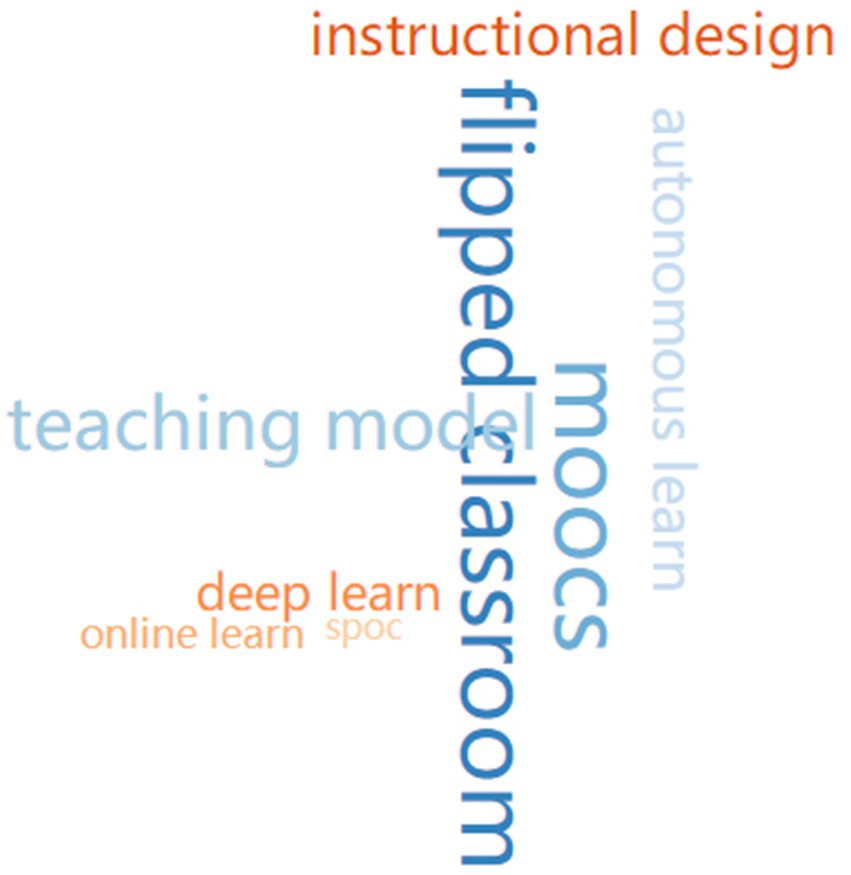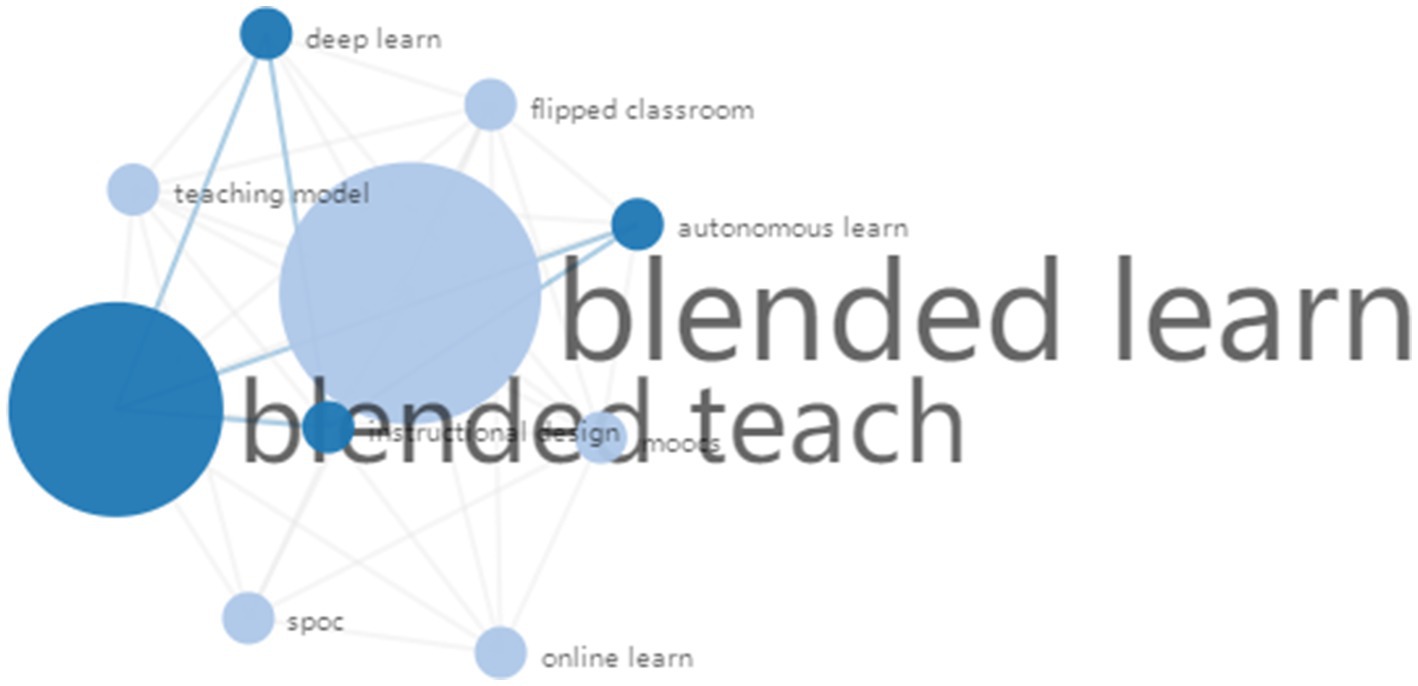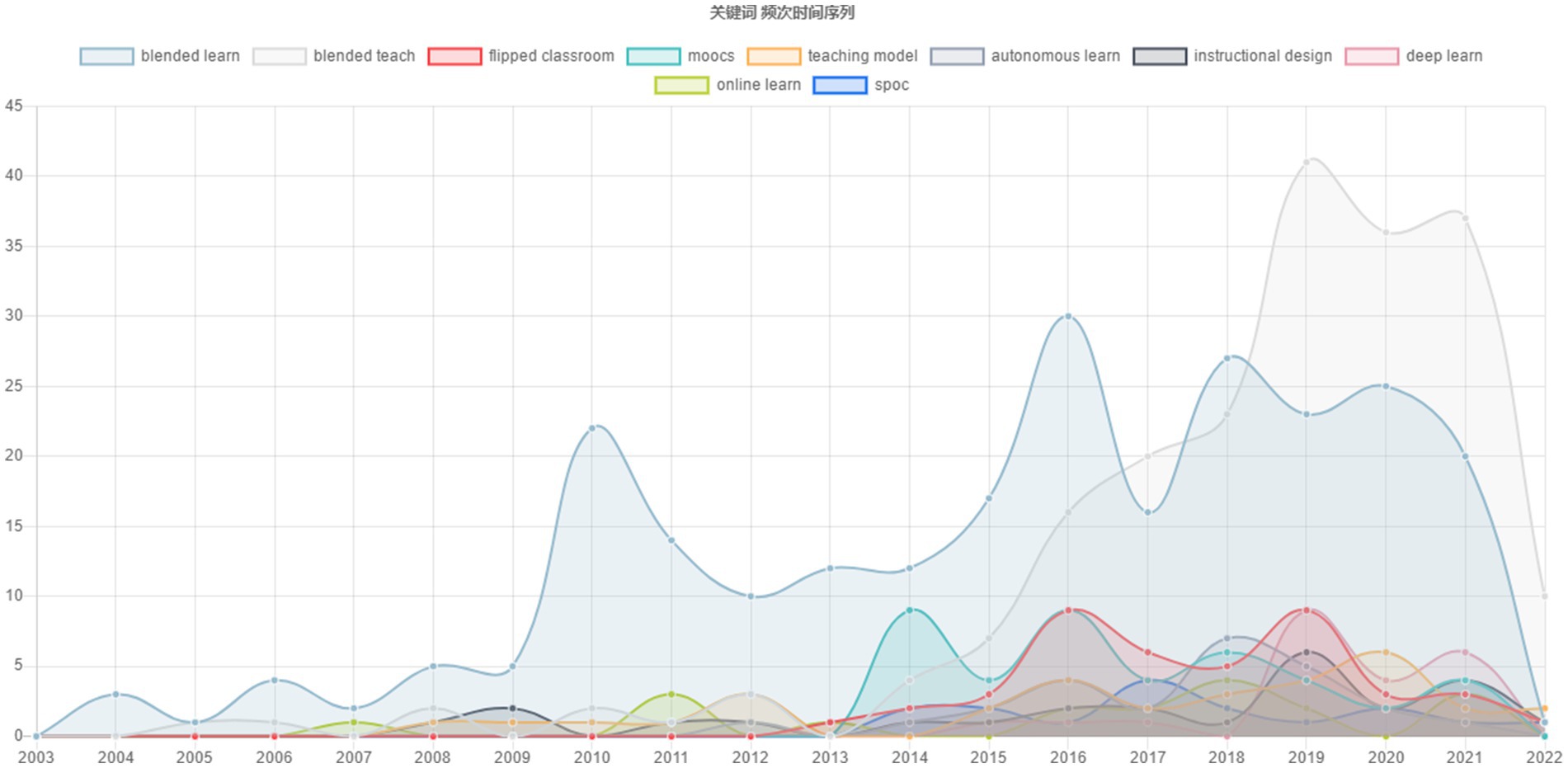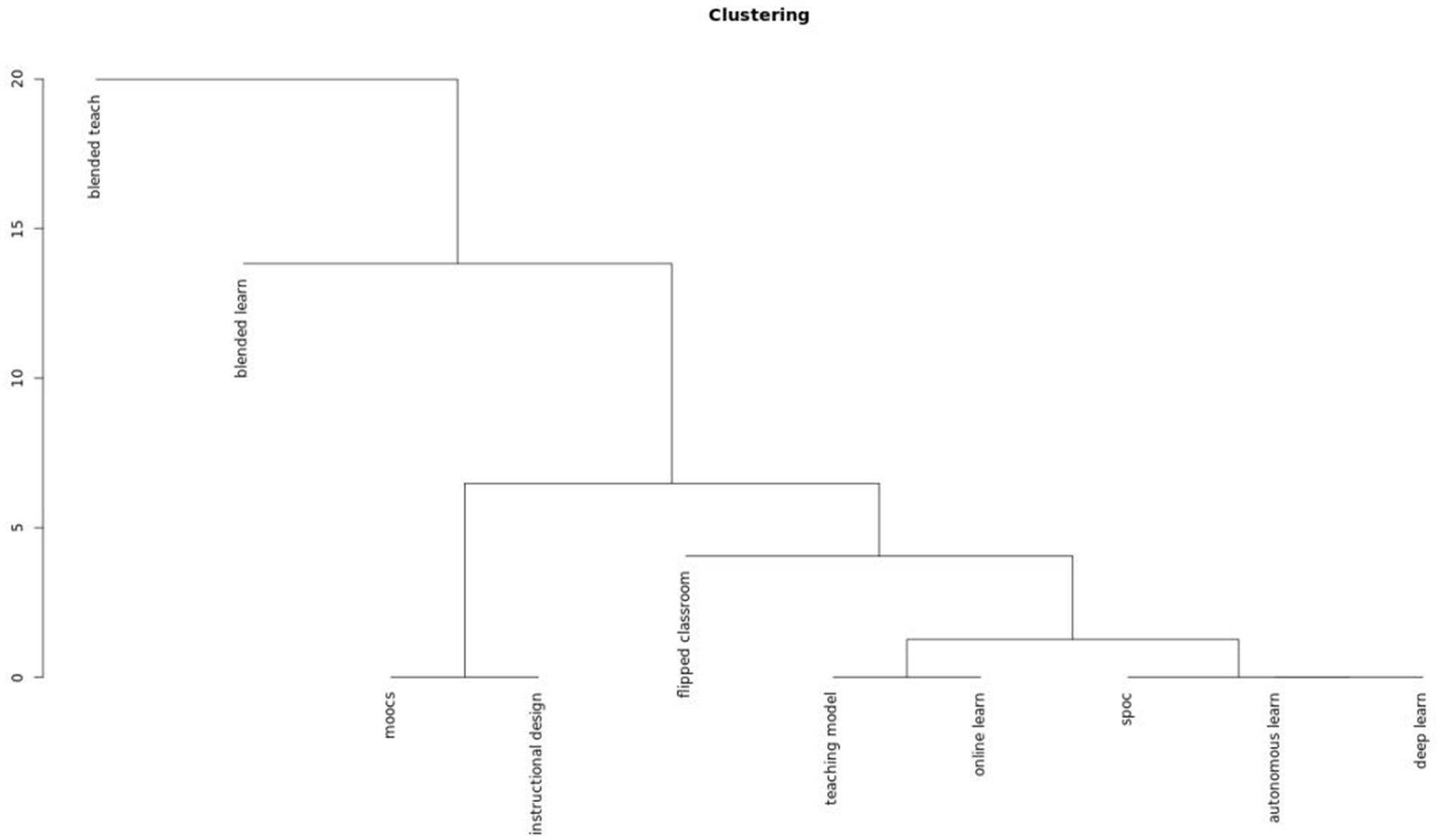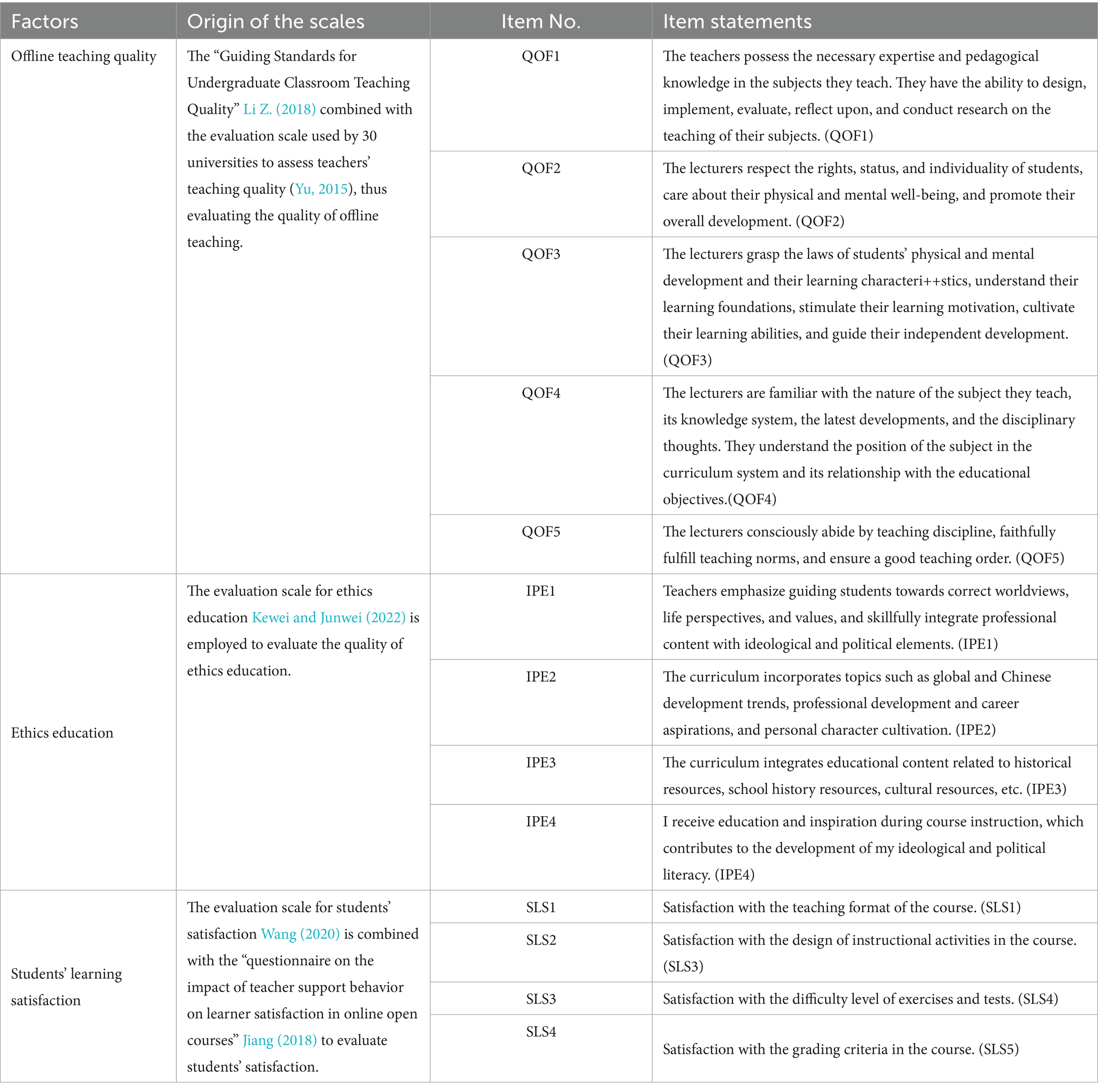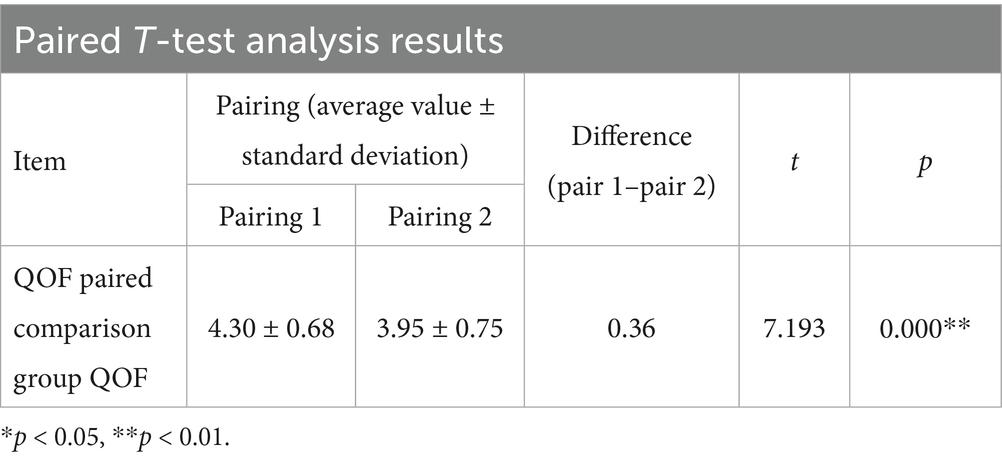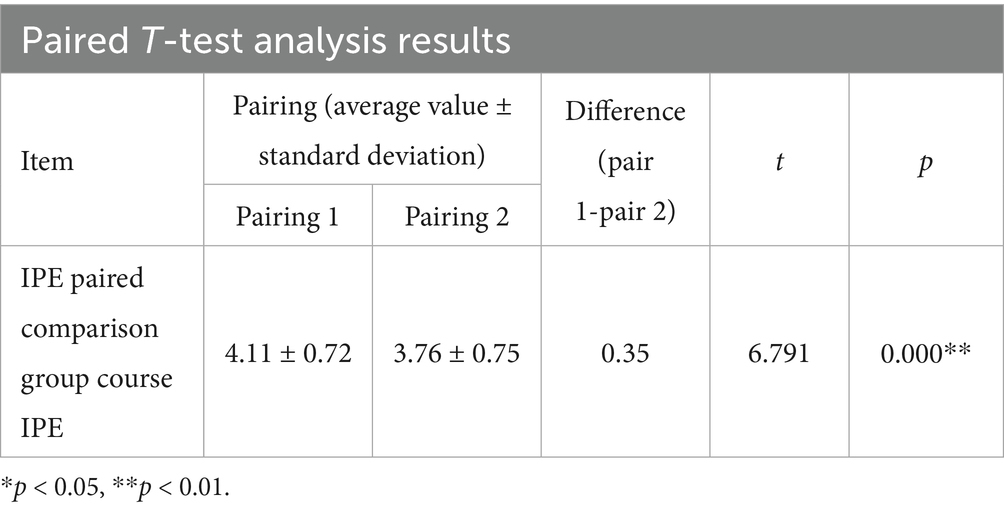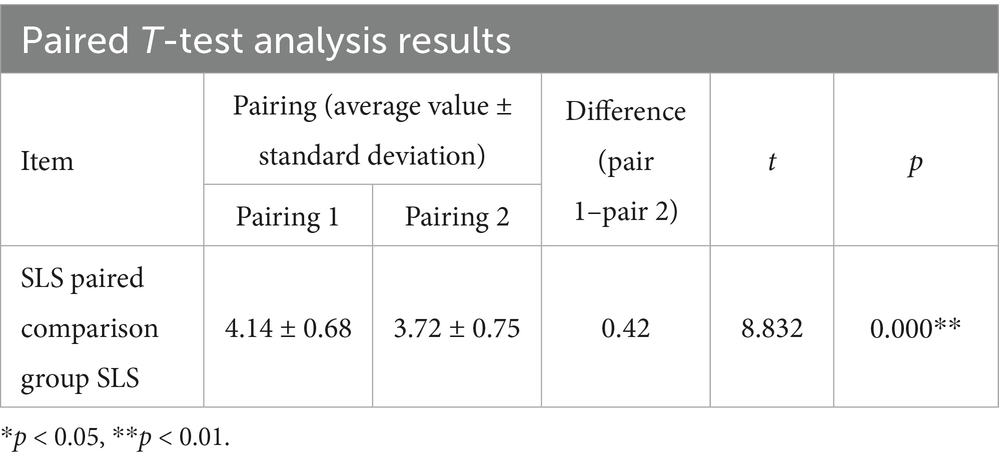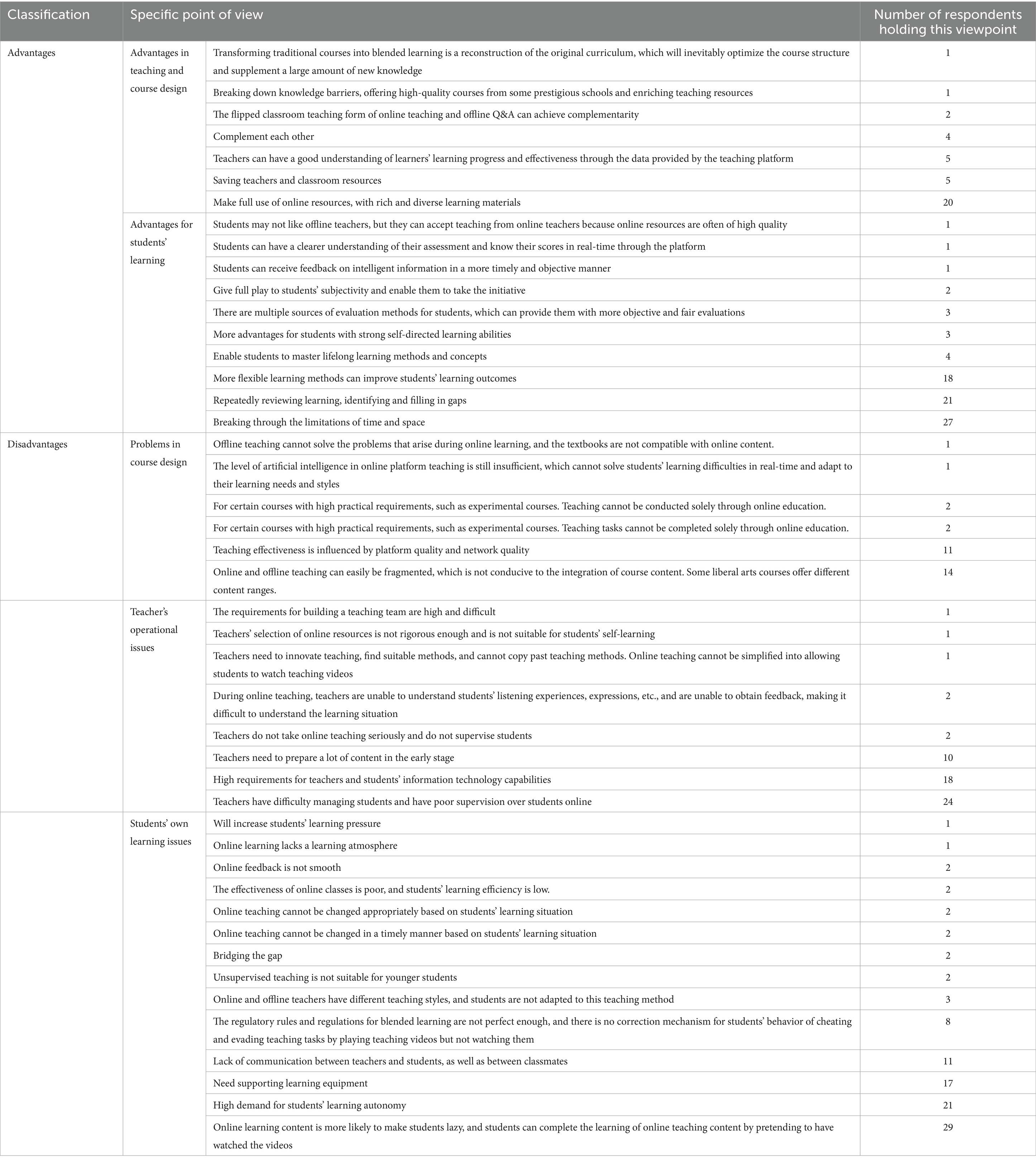- 1Zhejiang Ocean University, Zhoushan, China
- 2Guangdong University of Science & Technology, Dongguan, China
- 3Taizhou Vocational and Technical College, Taizhou, China
This study examines the evolution of blended learning in China, anchored in Massive Open Online Courses (MOOCs) and Small Private Online Courses (SPOCs), and evaluates its effects on teaching quality, ethics education, and student satisfaction. Combining literature review and quantitative analysis, the research demonstrates that blended learning surpasses traditional pedagogy across these three dimensions—a finding further validated through follow-up interviews. However, students identified notable limitations, including a tendency for online content to foster passive learning and challenges for instructors in classroom management. To address these issues, the paper proposes that educators prioritize content coherence in course design and incorporate student feedback on platform usability to optimize both pedagogical effectiveness and learning outcomes. Future studies should investigate the cost-efficacy of blended learning, specifically its capacity to sustain or elevate educational standards with reduced instructional resources.
1 Introduction
When discussing blended learning in China, scholars often refer to MOOCs-based or SPOCs-based blended learning. Blended learning, as a teaching method, gained rapid popularity in China following the widespread adoption of MOOCs and SPOCs. The history of blended learning predates that of MOOCs and encompasses a learning model that combines the advantages of traditional classroom learning and online learning. Blended learning aims to maximize learning outcomes in the most cost-effective manner, earning consensus within the international educational technology community.
Initially, scholars offered varied perspectives on blended learning, which can be summarized as follows: Singh and Reed (2001) defines blended learning as a teaching method that effectively transfers “appropriate” knowledge and skills to learners, using “suitable” instructional technology and teaching styles at an opportune time to achieve optimal teaching outcomes. In China, He (2004), a renowned educational technology expert, proposes that blended learning is a new teaching approach that integrates traditional offline learning methods with the learning advantages facilitated by modern technology networks. In this context, teachers play a crucial role in guiding students’ learning initiative, fostering their enthusiasm for learning, promoting creative thinking, and monitoring their overall learning process. Carman (2005), the president of Agilent Learning, identifies five key factors determining the quality of blended learning: live events, performance support materials, self-paced learning, assessment, and collaboration. Moreover, he is highly confident in the future of blended learning. He believes that the key factor lies in the quality of teaching content. As long as the quality of teaching content can be ensured, blended learning will prove to be an exceptional teaching method.
Based on the aforementioned definition, blended learning emerged with the advent of the internet and integrated with traditional teaching processes. Moreover, it is widely acknowledged that the optimal learning outcomes of blended learning can be achieved by combining traditional and online learning, leveraging their respective strengths. In comparison, blended learning encompasses a broader research scope than MOOCs, with MOOCs being considered as a subset of blended learning (Li W., 2018).
Over time and with the advancement of new technologies, scholars today have developed new insights and perspectives on blended learning. Hrastinski (2019) provides varying definitions, models, conceptualizations, and meanings. According to him, blended learning has become a general concept that not only combines online course content for learning purposes. Blended learning includes the integration of teaching methods and other elements at multiple levels, such as the combination of different technical tools, although these blends may not align with the most influential definition of blended learning. Johannes (2020) challenges the notion that blended learning must be built upon face-to-face and online instruction. Furthermore, he offers a new definition: blended learning involves the appropriate utilization of various methods, technologies, and theories to optimize learning within a designated environment.
Despite the numerous studies and papers on Blended Learning that currently exist, comprehensive research that encompasses all majors across the entire school is remarkably scarce. There is an urgent need for relevant research to address these issues. This study aims to fill this research gap by conducting a quantitative comparative analysis primarily focusing on three aspects: teaching quality, ethics education and students’ learning satisfaction, as compared to traditional teaching methods. Additionally, qualitative interviews will be supplemented, followed by extensive qualitative viewpoint categorization and analysis.
In this study, blended learning specifically referred to the blended learning based on MOOCs and SPOCs. In these courses, certain teaching content was arranged for students to learn independently through MOOCs and SPOCs, and corresponding scores were given. At the same time, teachers were also required to complete offline teaching tasks, which should account for no less than half of the total class hours.
2 Literature review-the development of blended learning in China
After Professor Kekang He introduced blended learning and constructivism to China for the first time, many Chinese educational technology scholars and experts began to study this research field (He, 2004). Blended learning has now become a popular topic for domestic teaching reform. In July 2022, a total of 5,136 articles with the theme of blended learning were retrieved from CNKI (China National Knowledge Internet). Among them, 569 articles are from core publications of Peking University or CSSCI (Chinese Social Sciences Citation Index).
Due to the large number of references, this study tends to utilize the statistical analysis tool of bibliographic information, SATI (Statistical Analysis Toolkit for Informatics), to analyze the 569 articles. This study aims to conduct visual centrality analysis on these Chinese papers using SATI. The analysis focuses on keywords, utilizing SATI for field extraction, word frequency statistics, and matrix generation. UCINET and Netdraw are then used to generate a visual network knowledge map. SATI is a mature software for literature analysis, and numerous studies have been conducted based on this software (Ren et al., 2024).
In this study, the data of 569 academic literature titles in Endnote format were imported into SATI 3.2 for keyword statistics, resulting in a total of 1,209 original keywords. Table 1 presented the top 10 keywords.
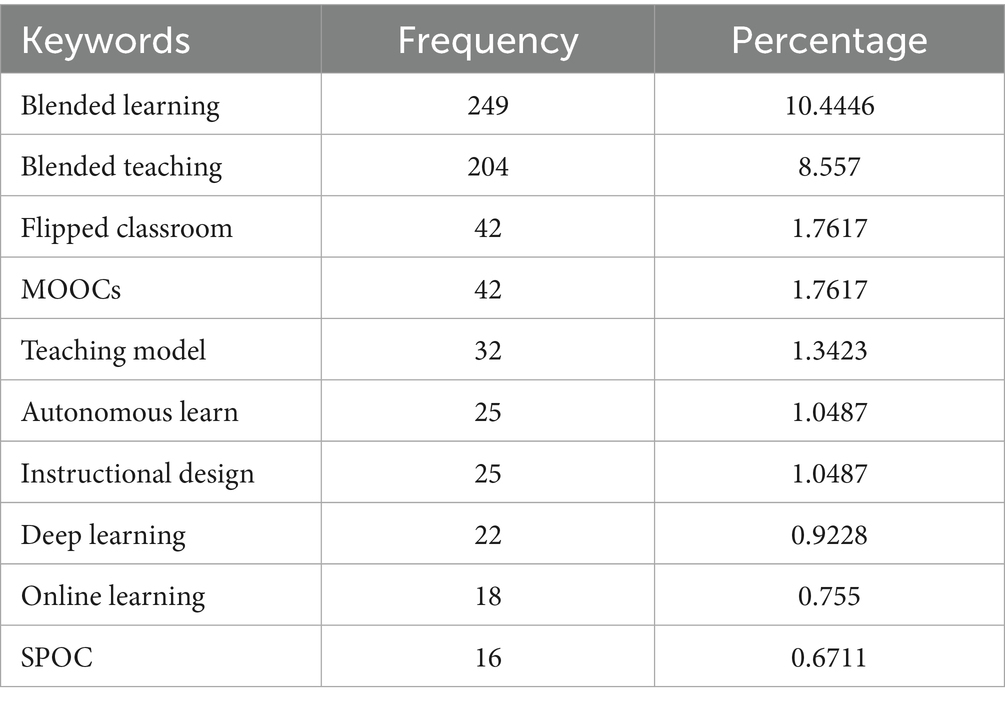
Table 1. Blended learning’s top 10 keywords with the largest number of topics retrieved from core publications of Peking University or CSSCI in CNKI.
The high-frequency keywords’ cloud image and knowledge map were presented in Figures 1, 2, respectively. Additionally, the temporal variation of keyword frequency was depicted in Figure 3.
Since the introduction of MOOCs in China in 2015, blended learning has gained traction and an increasing number of articles on this topic have emerged. In particular, after the Ministry of Education issued relevant policies on blended teaching in 2018 (Wu, 2018), the term “blended teaching” began to surpass “blended learning” in popularity.
Among the keywords analyzed, MOOCs, online learning, and SPOCs were among the top 10, indicating a close relationship between blended learning in China and these two forms of online learning. The association between these keywords was illustrated in Figure 4.
It is evident that research on blended learning is thriving in China. The relatively lower number of articles in 2022 compared to 2021 can be attributed to the fact that the retrieval for this study was conducted in July 2022, and many articles published later in 2022 were not yet included in CNKI.
3 Research methods
3.1 Population and sampling
In order to ensure a diverse and representative sample, this study focused on students who were currently on campus and actively participating in blended learning programs that utilized Massive Open Online Courses (MOOCs) or Small Private Online Courses (SPOCs) within Zhejiang, China.
To determine an appropriate sample size, this study referred to the Krecjie and Morgan Sample Size Determination Table and also considered the official figures provided on Zhejiang Ocean University’s website, which indicated a total student population of around 13,000. To ensure the reliability of the survey, valuable feedback was collected from a carefully selected sample of 375 individuals (Chaokromthong and Sintao, 2021; Chuan and Penyelidikan, 2006; Krejcie and Morgan, 1970).
This study selected two groups of samples. The first group comprised students who were currently on campus and actively participating in blended learning programs that utilized Massive Open Online Courses (MOOCs) or Small Private Online Courses (SPOCs) at Zhejiang Ocean University. The second group consisted of students who were learning through traditional teaching methods.
Unlike most studies that chose a single course for research, this study sampled all types of courses, including agricultural and forestry, engineering, liberal arts, and science courses. Therefore, the scope of this research was not limited to a single course. Moreover, the samplers in this study were from the school’s academic affairs administration, not the respondents’ instructors, which ensured that the questionnaire sampling was more objective and fair. Students would not give higher scores merely because their own instructors were conducting course research for teaching reform. All samples in this study were randomly selected, with data sourced from student ratings in the teaching evaluation system. The research was not limited to any specific discipline, ensuring its generalizability and compliance with random sampling requirements.
3.2 Sampled courses: academic disciplines
The academic classification of these 7 courses was shown in the Table 2 below. The students’ academic backgrounds came from all majors at Zhejiang Ocean University, with no specific focus on a particular major.
The courses selected for this study were exclusively sourced from esteemed provincial or national first-class curriculums. Encompassing diverse subject areas such as humanities, science, and engineering, these carefully chosen course samples effectively depicted the collective proficiency of blended teaching practices within ordinary higher education institutions in Zhejiang Province. By thoroughly examining these representative course samples, this study offered invaluable insights into the overarching quality of blended teaching throughout Zhejiang Province’s ordinary higher education institutions.
3.3 Tools
Since the school-wide academic evaluation primarily focused on three crucial aspects: the quality of teachers’ offline teaching, ethics education, and students’ learning satisfaction. This selective emphasis took into account the diversity of disciplines and other pertinent considerations. Hence, the study specifically concentrated on comparing the differences in these three factors. By utilizing rigorous statistical analysis, the study was expected to provide valuable insights and recommendations for further enhancing the academic evaluation system within the school. The evaluation scale for these three factors was shown in the Table 3 below. The scales adopted in this study are classic instruments that have been repeatedly utilized and validated in Chinese pedagogical research.
Subsequent to the quantitative analysis phase, the research methodology incorporated a qualitative component through in-depth personnel interviews.
3.4 Research questions and hypothesis
RQ1: Have the current blended learning reforms achieved success over traditional teaching methods in terms of teaching quality?
RQ2: Have the current blended learning reforms in achieved success over traditional teaching methods in terms of ethics education in the curriculum?
RQ3: Have the current blended learning reforms achieved success over traditional teaching methods in terms of students’ learning satisfaction?
RQ1 Hypothesis 1: Is quality of offline teaching in blended learning better than in traditional teaching?
RQ2 Hypothesis 2: Is ethics education in blended learning better than in traditional teaching?
RQ3 Hypothesis 3: Is students’ learning satisfaction in blended learning higher than in traditional teaching?
4 Empirical research
This study aimed to enhance the overall academic evaluation within the school by conducting a comprehensive analysis. To achieve this, a 5-point scale was developed by the researchers, which was widely recognized as an official and classic scale in China. Subsequently, a random sample of 375 students was chosen from traditional offline courses.
The Cronbach’s coefficients for QOF, IPE, and SLS are 0.973, 0.954, and 0.938, respectively. This demonstrates that the scale data are highly reliable and suitable for research analysis. For detailed data, please refer to Tables 4–6 below.
The sample size in this study was sufficiently large, and strict random sampling was employed during data collection, thereby satisfying the assumption of normal distribution and justifying the use of paired T-test analysis. To assess potential significant differences, paired T-test analysis and variance testing were conducted on the collected data from both groups. The measurement scales utilized in this research underwent rigorous review and validation by experts from the Academic Affairs Office of Zhejiang Ocean University, as well as by education specialists across the institution.
4.1 Comparative analysis of offline teaching quality between blended learning and traditional teaching by paired T-test
RQ1: Have the current blended learning reforms achieved success over traditional teaching methods in terms of teaching quality?
Through the paired T-test analysis results of QOF between blended learning and traditional teaching as presented in Table 7, it could be observed that the hypothesis 1 was validated to be true.
A significant difference of 0.01 was observed between the offline teaching quality in blended learning and the comparison group (t = 7.193, p = 0.000). Specifically, the mean value of the offline teaching quality in the blended learning group was 4.30, which was significantly higher than the mean value of the offline teaching in the comparison group, which was 3.95.
4.2 Comparative analysis of ethics education between blended learning and traditional teaching by paired T-test
RQ2: Have the current blended learning reforms in achieved success over traditional teaching methods in terms of ethics education in the curriculum?
Through the paired T-test analysis results of IPE between blended learning and traditional teaching as presented in Table 8, it could be observed that the hypothesis 2 was validated to be true.
There was a significant difference at the 0.01 level between IPE and the comparison group’s course IPE. The t-value was 6.791 (p = 0.000). Specifically, the average value of IPE (4.11) in the blended learning group was significantly higher than the average value of the IPE in the comparison group (3.76).
4.3 Comparative analysis of students’ learning satisfaction between blended learning and traditional teaching by paired T-test
RQ3 Hypothesis 3: Is students’ learning satisfaction in blended learning higher than in traditional teaching?
Through the paired T-test analysis results of SLS between blended learning and traditional teaching as presented in Table 9, it could be observed that the hypothesis 3 was validated to be true.
A significant difference at the 0.01 level existed between satisfaction in blended learning and satisfaction in the comparison group. The t-value was 8.832 (p = 0.000). Specifically, the average value of satisfaction (4.14) in the blended learning group was significantly higher than the average value of satisfaction in the comparison group (3.72).
In the paired T-test analysis, students’ evaluations of the three factors of offline teaching quality, ethics education, and satisfaction of blended teaching were higher than those of students in traditional teaching. It could be considered that blended learning had advantages over traditional offline teaching in these three aspects.
4.4 Qualitative interview for the advantage and disadvantage of blended learning
In the qualitative interview, this study used a question-and-answer format to ask students specific question: “The relevant research indicates that students’ learning evaluations of blended teaching are higher than those of traditional teaching. Do you agree with this viewpoint? What are the specific reasons?”
All the interviewees unanimously endorsed this perspective, with several specific arguments outlined as follows:
Student H SJ:
“I agree with this point. Blended learning is a learning approach that combines online learning with traditional classroom instruction. By utilizing information technology, it provides students with more flexible and personalized learning experiences, aiming to enhance learning outcomes and improve teaching quality. Blended learning breaks the constraints of time and space, allowing students to choose their learning schedule according to their own time availability. They can engage in online courses anytime and anywhere, offering higher flexibility. Blended learning leverages a variety of learning resources, such as web videos and e-books, enriching the diversity of learning content, which can better meet students’ needs. Additionally, blended learning emphasizes interactivity and collaborative learning. Through platforms like discussion forums and online communities, students can communicate and collaborate with teachers and peers, thereby improving learning outcomes.”
Student L YC:
“I concur. Firstly, blended learning is a pedagogical model that integrates traditional face-to-face instruction with online learning, which has been gaining popularity in the educational field in recent years. This model offers students a more flexible way of learning and effectively promotes their academic achievements. In terms of the advantages of blended learning, this approach combines the strengths of both face-to-face and online learning. Firstly, students can freely choose their learning location and time according to their schedules, without being bound by the constraints of traditional classrooms. Secondly, through online learning platforms, students can access learning materials and resources at any time and from any place, enhancing the efficiency and convenience of learning. Furthermore, blended learning fosters collaboration and communication among students through online interactions, cultivating their teamwork and communication skills. It appears that blended learning offers advantages that traditional learning cannot achieve, which is beneficial for students' learning. Therefore, students exhibit higher satisfaction in blended learning compared to traditional teaching methods.”
As no dissenting opinions emerged, this study proceeded to design a question to inquire about the advantages and disadvantages of blended learning. The specific question was: “What are the advantages and disadvantages of blended learning?” Some specific cases were as follows:
Teacher D HW:
“Blended learning offers a more comprehensive approach encompassing both offline courses for intuitive knowledge acquisition and face-to-face interaction with teachers, along with online learning. In terms of time and space, it grants more freedom and convenience, catering to diverse student needs across various courses. However, it also disrupts the traditional offline teaching model and necessitates additional equipment. Initial adaptation challenges may hinder students from achieving desired outcomes initially.”
Student W Y:
“Advantages: Blended learning offers diversified learning modes that create a new training experience. Traditional teaching models are limited by scene and space constraints, making it challenging to strike a balance between effectiveness and enjoyment in training. In the context of blended learning, training becomes more interactive. By incorporating game elements into the learning environment and designing a series of learning plans aligned with employees' skill development paths and career goals, each training task can be completed with certain challenges and difficulties, leading to corresponding rewards. This gamified approach effectively stimulates students' enthusiasm for learning and enhances training efficiency.
“Disadvantage: There is a certain operational threshold associated with blended learning. Teachers need to acquire specific information technology skills and develop operational guidelines and training details in advance while conducting training programs. Furthermore, instructors must possess skills in courseware design, course recording, and teaching design. These aspects place a certain level of demand on teachers' abilities.”
Overall, through qualitative interviews, many students and teachers expressed great fondness for and acceptance of this teaching model, hoping to use it for teaching and learning. The respondents generally held a positive attitude towards blended learning. However, there were also many students who voiced dissatisfaction with online teaching and discomfort with the blended teaching approach.
4.5 Qualitative analysis and classification of advantages and disadvantages in blended learning
The classification of responses to the aforementioned qualitative interview questions is presented in Table 10 below.
Through these interviews, this research had identified the primary issue associated with blended learning as follows: “Online learning content tends to foster student passivity, where students may easily opt to complete their learning by simply pretending to have watched instructional videos.” Additionally, this research found challenges related to “high expectations for students’ autonomy in learning” and “difficulties faced by teachers in managing and supervising students online.” Moving forward, these shortcomings could be addressed and rectified through a comprehensive analysis and corrective measures focusing on three areas: curriculum design, teacher strategies, and student engagement.
5 Findings
According to 4.1, 4.2, 4.3 and 4.4, this study summarized the hypotheses as shown in the following Table 11.
Based on the Paired T-test in Tables 7–9, it could be observed that students’ evaluation of blended learning was better than that of traditional teaching courses. In terms of students’ learning satisfaction, they generally exhibited higher levels of satisfaction with the MOOCs or SPOCs based blended learning commonly adopted in China compared to traditional teaching methods.
However, in subsequent qualitative interviews, many individuals expressed their opinions and concerns regarding online teaching, suggesting significant shortcomings. These concerns centered around the challenges faced by teachers in managing and supervising students online, as well as the potential for online learning content to cultivate student passivity, with students resorting to simulated completion of tasks without fully engaging with the instructional materials. Consequently, it would be inappropriate to simply accept the conclusions derived from quantitative analyses.
Blended learning approaches, which combined online and traditional teaching methods, offered distinct advantages, particularly in terms of enhancing student satisfaction, as acknowledged by students themselves. Nevertheless, it would be erroneous to attribute the effectiveness of blended learning solely to the adoption of conventional teaching practices. Thus, it is imperative to undertake further research to comprehensively investigate and delve into this issue.
6 Conclusions and suggestions
Conclusion 1: The integration of some online and offline courses within the overall instructional design was not effectively established, leading to fragmented educational content. Some students even perceived this as engaging with two distinct courses. This situation was predominantly due to the fundamental dissimilarities in the instructional content of certain subjects. For example, “The Ocean of Film and Television—Exploring Camera and Post Production Techniques” was bifurcated into photography and video production processing. Likewise, “Traditional Chinese Studies and Social Life” was presented in two parts: an introduction to traditional Chinese culture and the understanding and application of Chinese culture in contemporary society. In the structuring of instruction, teachers directly provided some relatively straightforward content as online courses.
Suggestion 1: To address this issue, teachers should not overlook the content taught online during offline courses. Instead, they can use appropriate references to demonstrate the interconnectedness of knowledge between the online and offline components. By doing so, students will not feel disconnected while studying.
Conclusion 2: The effectiveness of teaching was influenced by the quality of the platform and network. When selecting a teaching platform, teachers should have fully considered its usability and accessibility. They should have also taken into account the appropriateness of the course content on the platform and strove to create online teaching resources themselves or incorporated their own content into existing teaching resources.
Suggestion 2: It is crucial to attach great importance to students’ evaluation of the teaching environment in order to enhance teaching. By incorporating their opinions on the teaching platform into the student evaluation scale, one can select the teaching platform based on their thoughts and judgments. Additionally, these opinions can serve as a significant basis for schools to choose online teaching platforms. This approach allows students to opt for their preferred or more adaptable learning platforms, thus improving teaching quality and learning efficiency.
7 Future recommendations and shortcomings
From the viewpoint of universities and educators, blended learning diminishes instructional expenses and alleviates the academic workload on college faculty. This method augments the investment and quality of teachers’ face-to-face instruction, affording them more time and energy for scholarly research. Regarding students’ learning contentment, surveyed students highly commend blended learning, as it also grants them greater autonomy in their educational pursuits.
Nevertheless, it merits inquiry whether blended learning yields superior educational outcomes compared to conventional instruction from the standpoint of learning results. Presently, although numerous articles extol the efficacy of employing blended learning for particular courses, these studies are frequently undertaken by the educators themselves, thereby lacking impartiality. Moreover, there is an absence of comprehensive, institution-wide research initiated by school administrators or academic affairs departments. From the perspective of institutional management, the prevailing assumption is often that increased input correlates with increased output. Given the diminished input in blended learning, further investigation is essential to ascertain whether the outcomes will correspondingly diminish.
Shortcomings of the study:
1. Subjectivity in measurement: The study’s reliance on student course evaluations—a subjective metric emphasizing learner satisfaction—limits its capacity to assess objective learning outcomes. Given the established disparity between satisfaction and academic performance (Chan et al., 2024; Lo and Wong, 2023), coupled with incomparable grading standards across disciplines, findings primarily reflect comparative subjective perceptions rather than empirically validating blended learning’s superiority in enhancing learning efficacy.
2. Institutional restriction in sampling: despite employing validated scales to ensure measurement reliability, the lack of standardized course evaluation systems across Chinese universities confined data collection to a single institution in Zhejiang Province. This constraint necessitates future efforts to adapt and implement the study’s evaluation framework across diverse institutional contexts.
3. Uncontrolled instructor variable: the potential correlation between instructors’ digital literacy and blended learning adoption remains unaddressed. Educators opting for technology-enhanced pedagogies may inherently possess higher technological competencies than traditional practitioners, introducing a confounding variable. Subsequent research must rigorously examine this factor’s influence through controlled experimental designs.
These limitations highlight critical avenues for future scholarly exploration.
Data availability statement
The original contributions presented in the study are included in the article/supplementary material, further inquiries can be directed to the corresponding authors.
Author contributions
WR: Conceptualization, Data curation, Formal analysis, Funding acquisition, Investigation, Methodology, Project administration, Resources, Software, Supervision, Validation, Visualization, Writing – original draft, Writing – review & editing. RW: Conceptualization, Data curation, Formal analysis, Funding acquisition, Investigation, Methodology, Project administration, Resources, Software, Supervision, Validation, Visualization, Writing – review & editing. XZ: Investigation, Resources, Writing – original draft, Writing – review & editing. JS: Investigation, Resources, Writing – original draft, Writing – review & editing.
Funding
The author(s) declare that financial support was received for the research and/or publication of this article. “2024 Higher Education Scientific Research Planning Project” by China Association of Higher Education: Research and Exploration on Teaching Evaluation Model Construction Empowered by Generative AI in Agricultural and Forestry Universities (Grant Number: 24NL0401).
Conflict of interest
The authors declare that the research was conducted in the absence of any commercial or financial relationships that could be construed as a potential conflict of interest.
Generative AI statement
The authors declare that Gen AI was used in the creation of this manuscript. AI is only used for article polishing.
Any alternative text (alt text) provided alongside figures in this article has been generated by Frontiers with the support of artificial intelligence and reasonable efforts have been made to ensure accuracy, including review by the authors wherever possible. If you identify any issues, please contact us.
Publisher’s note
All claims expressed in this article are solely those of the authors and do not necessarily represent those of their affiliated organizations, or those of the publisher, the editors and the reviewers. Any product that may be evaluated in this article, or claim that may be made by its manufacturer, is not guaranteed or endorsed by the publisher.
References
Carman, J. M. (2005). Blended learning design: five key ingredients. Availale online at: https://www.researchgate.net/publication/238687086Blended_learning_design_Five_key_ingredients
Chan, S. T. S., Lo, N. P. K., and Wong, A. M. H. (2024). Enhancing university level English proficiency with generative AI: empirical insights into automated feedback and learning outcomes. Contemp. Educ. Technol. 16:ep541. doi: 10.30935/cedtech/15607
Chaokromthong, K., and Sintao, N. (2021). Sample size estimation using Yamane and Cochran and Krejcie and Morgan and green formulas and Cohen statistical power analysis by G* power and comparisions. APHEIT Int. J. 10, 76–86.
Chuan, C. L., and Penyelidikan, J. (2006). Sample size estimation using Krejcie and Morgan and Cohen statistical power analysis: a comparison. J. Penyelid. IPBL 7, 78–86.
He, K. (2004). On the new development of educational technology theory from blended learning. E-Educ. Res. 2004, 1–6.
Hrastinski, S. (2019). What do we mean by blended learning? TechTrends 63, 564–569. doi: 10.1007/s11528-019-00375-5
Jiang, Z. (2018). Research of influence of teacher support behavior on learners satisfaction in online open course. Wuhan, China: Central China Normal University.
Johannes, C. C. (2020) Towards a new definition of blended learning. Electro. J. eLearn. 18, 114–121. Available online at: www.ejel.org
Kewei, W., and Junwei, H. (2022). Technology-empowered accurate online curriculum ideological and political education—an analysis of satisfaction and effectiveness. Educ. Res. Mon. 8, 37–44. doi: 10.16477/j.cnki.issn1674-2311.2022.05.006
Krejcie, R. V., and Morgan, D. W. (1970). Determining sample size for research activities. Educ. Psychol. Meas. 30, 607–610. doi: 10.1177/001316447003000308
Li, W. (2018). A comparative study of three common blended teaching modes in the context of MOOC. Mod. Educ. Technol. 28:510.
Li, Z. (2018). A study on design and implementation of classroom teaching quality standards of undergraduate course—taking D university as a case. Changchun China: Northeast Normal University.
Lo, N. P. K., and Wong, A. M. H. (2023). Reimagining teaching and learning in higher education. In Critical reflections on ICT and education: selected papers from the HKAECT 2023 international conference (p. 215). Springer Nature
Ren, W., Wang, R., Mohamad, S. N. A., Xie, Y., Chen, L., Ning, H., et al. (2024). A quantitative analysis of the influence of ideological and political education on students’ learning satisfaction. J. Infrastruct. Policy Dev. 8, 1–14. doi: 10.24294/jipd.v8i1.2727
Singh, H., and Reed, C.. (2001). A white paper: achieving success with blended learning. Available online at: https://www.researchgate.net/publication/265530153_A_White_Paper_Achieving_Success_with_Blended_Learning (Accessed January 2001).
Wang, G. (2020). Research on the effect of college students' learner characteristics on online and offline blended learning. Xian, China: Shanxi Normal University.
Keywords: blended learning based on MOOCs or SPOCs, students’ learning satisfaction, teaching quality, comparative study, multidisciplinary teaching research
Citation: Ren W, Wang R, Zhao X and Shi J (2025) A comparative analysis of the advantages and disadvantages of blended learning and traditional teaching in a multidisciplinary context. Front. Educ. 10:1659590. doi: 10.3389/feduc.2025.1659590
Edited by:
Abusufiyan Shaikh, Anjuman-I-Islam's Kalsekar Technical Campus, IndiaReviewed by:
Noble Lo, Lancaster University, United KingdomRuixue Liu, Northwest Normal University, China
Copyright © 2025 Ren, Wang, Zhao and Shi. This is an open-access article distributed under the terms of the Creative Commons Attribution License (CC BY). The use, distribution or reproduction in other forums is permitted, provided the original author(s) and the copyright owner(s) are credited and that the original publication in this journal is cited, in accordance with accepted academic practice. No use, distribution or reproduction is permitted which does not comply with these terms.
*Correspondence: Wenxuan Ren, cmVud2VueHVhbkB6am91LmVkdS5jbg==; Rui Wang, d2FuZ3J1aUB6am91LmVkdS5jbg==
 Wenxuan Ren
Wenxuan Ren Rui Wang1*
Rui Wang1*